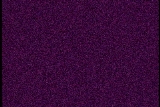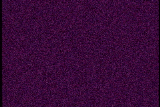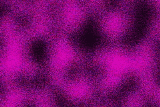
Closed-eye hallucination
Encyclopedia
Closed-eye hallucinations and closed-eye visualizations (CEV) are a distinct class of hallucination
. These types of hallucinations generally only occur when one's eyes are closed or when one is in a darkened room. They are a form of phosphene
.
Certain users report closed-eye hallucinations under the influence of psychedelics. These are reportedly of a different nature than the "open-eye" hallucinations of the same compounds.
s.
 The most basic form of CEV perception that can be immediately experienced in normal waking consciousness involves a seemingly random noise of pointillistic light/dark regions with no apparent shape or order.
The most basic form of CEV perception that can be immediately experienced in normal waking consciousness involves a seemingly random noise of pointillistic light/dark regions with no apparent shape or order.
This can be seen when the eyes are closed and looking at the back of the eyelids. In a bright room, a dark red can be seen, owing to a small amount of light penetrating the eyelids and taking on the color of the blood within them. In a dark room, blackness can be seen or the object can be more colourful. But in either case it is not a flat unchanging redness/blackness. Instead, if actively observed for a few minutes, one becomes aware of an apparent disorganized motion, a random field of lightness/darkness that overlays the redness/blackness of your closed eyelids.
For a person who tries to actively observe this closed-eye perception on a regular basis, there comes a point where if they look at a flat-shaded object with their eyes wide open, and try to actively look for this visual noise, they will become aware of it and see the random pointillistic disorganized motion as if it were a translucent overlay on top of what is actually being seen by their open eyes.
When seen overlaid onto the physical world, this CEV noise does not obscure physical vision at all, and in fact is hard to notice if the visual field is highly patterned, complex, or in motion. When active observation is stopped, it is not obvious or noticeable, and seemingly disappears from normal physical perception. Individuals suffering from visual snow
see similar noise but experience difficulty blocking it from conscious perception.
The noise probably originates from thermal noise
exciting the photoreceptor cells in the retina, compare Eigengrau
.
 This level is relatively easily accessible to people who use LSD
This level is relatively easily accessible to people who use LSD
, and appears to be what most people refer to as colourful visuals.
However, it is also accessible to people involved in deep concentration for long periods of time. When lying down at night and closing the eyes, right before sleep the complex motion of these patterns can become directly visible without any great effort thanks to hypnagogic hallucination
.
The patterns themselves might resemble fractals.
Opening the eyes returns one to the normal physical world, but still with the CEV object field overlaid onto it and present. In this state it is possible to see things that appear to be physical objects in the open-eye physical world, but that aren't really there.
This is the point where most hallucinogenic references say it is a good idea to have a "sitter
" present to watch over the person using the chemicals, and keep them from accidentally harming themselves or others while deep into their own world.
) that can be seen as dots darting around when staring up into a bright blue sky on a sunny day (not looking at the sun). These dots superimposed over a flat blue background are white blood cells moving through the blood vessels of the retina. The motion of waking-consciousness CEV noise is uniformly random compared to the waking-consciousness blue-sky sprite motion.
Hallucination
A hallucination, in the broadest sense of the word, is a perception in the absence of a stimulus. In a stricter sense, hallucinations are defined as perceptions in a conscious and awake state in the absence of external stimuli which have qualities of real perception, in that they are vivid,...
. These types of hallucinations generally only occur when one's eyes are closed or when one is in a darkened room. They are a form of phosphene
Phosphene
A phosphene is a phenomenon characterized by the experience of seeing light without light actually entering the eye. The word phosphene comes from the Greek words phos and phainein...
.
Certain users report closed-eye hallucinations under the influence of psychedelics. These are reportedly of a different nature than the "open-eye" hallucinations of the same compounds.
Levels of CEV perception
There are five known levels of CEV perception which can be achieved either through chemical stimuli or through meditative relaxation techniqueRelaxation technique
A relaxation technique is any method, process, procedure, or activity that helps a person to relax; to attain a state of increased calmness; or otherwise reduce levels of anxiety, stress or anger...
s.
Level 1: Visual noise

This can be seen when the eyes are closed and looking at the back of the eyelids. In a bright room, a dark red can be seen, owing to a small amount of light penetrating the eyelids and taking on the color of the blood within them. In a dark room, blackness can be seen or the object can be more colourful. But in either case it is not a flat unchanging redness/blackness. Instead, if actively observed for a few minutes, one becomes aware of an apparent disorganized motion, a random field of lightness/darkness that overlays the redness/blackness of your closed eyelids.
For a person who tries to actively observe this closed-eye perception on a regular basis, there comes a point where if they look at a flat-shaded object with their eyes wide open, and try to actively look for this visual noise, they will become aware of it and see the random pointillistic disorganized motion as if it were a translucent overlay on top of what is actually being seen by their open eyes.
When seen overlaid onto the physical world, this CEV noise does not obscure physical vision at all, and in fact is hard to notice if the visual field is highly patterned, complex, or in motion. When active observation is stopped, it is not obvious or noticeable, and seemingly disappears from normal physical perception. Individuals suffering from visual snow
Visual snow
Visual snow is a transitory or persisting visual symptom where people see snow or television-like static in parts or the whole of their visual fields, especially against dark backgrounds...
see similar noise but experience difficulty blocking it from conscious perception.
The noise probably originates from thermal noise
Dark current (physics)
In physics and in electronic engineering, dark current is the relatively small electric current that flows through photosensitive devices such as a photomultiplier tube, photodiode, or charge-coupled device even when no photons are entering the device. It is referred to as reverse bias leakage...
exciting the photoreceptor cells in the retina, compare Eigengrau
Eigengrau
Eigengrau , also called Eigenlicht , dark light, or brain gray, is the color seen by the eye in perfect darkness...
.
Level 2: Light/dark flashes
Some mental control can be exerted over these closed-eye visualizations, but it usually requires a bit of relaxation and concentration to achieve. When properly relaxed it is possible to cause regions of intense black, bright white or even colors such as yellow, green, or pink to appear in the noise. These regions can span the entire visual field, but seem to be fleeting in nature.Level 3: Patterns, motion, and color

LSD
Lysergic acid diethylamide, abbreviated LSD or LSD-25, also known as lysergide and colloquially as acid, is a semisynthetic psychedelic drug of the ergoline family, well known for its psychological effects which can include altered thinking processes, closed and open eye visuals, synaesthesia, an...
, and appears to be what most people refer to as colourful visuals.
However, it is also accessible to people involved in deep concentration for long periods of time. When lying down at night and closing the eyes, right before sleep the complex motion of these patterns can become directly visible without any great effort thanks to hypnagogic hallucination
Hypnagogia
Hypnagogia is the transitional state between wakefulness and sleep , originally coined in adjectival form as "hypnagogic" by Alfred Maury....
.
The patterns themselves might resemble fractals.
Level 4: Objects and things
This is a fairly deep state. At this level, thoughts visually manifest as objects or environments. When this level is reached, the CEV noise seems to calm down and fade away, leaving behind an intense flat ordered blackness. The visual field becomes a sort of active space. A side component of this is the ability to feel motion when the eyes are closed.Opening the eyes returns one to the normal physical world, but still with the CEV object field overlaid onto it and present. In this state it is possible to see things that appear to be physical objects in the open-eye physical world, but that aren't really there.
Level 5: Overriding physical perception
This is the point where it appears to the outside world that a person is either unconscious or insane. The internal CEV perceptions and think-it/feel-it perceptions become stronger than physical perceptions, and completely override and replace open-eye physical perceptions. This can be a potentially dangerous state if a person is still mobile while in a different imagined world, but by this time most people are motionless and not likely to do something hazardous to themselves or others.This is the point where most hallucinogenic references say it is a good idea to have a "sitter
Trip sitter
Trip sitter is a term used by recreational or spiritual drug users to describe a person who remains sober to ensure the safety of the drug user while he or she is under the influence of a drug; they are especially common with first-time experiences or when using psychedelics, dissociatives and...
" present to watch over the person using the chemicals, and keep them from accidentally harming themselves or others while deep into their own world.
Image burn-in (afterimage)
Image burn-in occurs when very bright objects lie in one's field of vision, and should not be confused with closed-eye hallucinations. Visual burn-in from bright lights is visible for a few minutes after closing the eyes, or by blinking repeatedly, but the burn-in effect slowly fades away as the retina recovers, whereas the waking-consciousness CEV noise will not disappear if observed continuously over a period of time.Corneal liquid
CEV does not involve the liquid and air bubbles on the surface of the cornea, which can also be seen by extremely nearsighted people when looking at bright point-light sources with glasses/contacts removed. Also called "Floaters" - often appear as cells floating across the eye. Half-closing and reopening the eyelids creates a very definite wiper-ridge in the corneal liquid that is readily visible. Fully closing and reopening the eyelids also stirs up the corneal liquid which settles down after a brief moment. The motion of waking-consciousness CEV noise is not so directly and physically controllable and repeatable. This is not necessarily only associated with extreme nearsightedness.Blue-sky sprites
CEV does not seem to be related to the "sprites" (blue field entoptic phenomenonBlue field entoptic phenomenon
The blue field entoptic phenomenon or Scheerer's phenomenon is the appearance of tiny bright dots moving quickly along squiggly lines in the visual field, especially when looking into bright blue light...
) that can be seen as dots darting around when staring up into a bright blue sky on a sunny day (not looking at the sun). These dots superimposed over a flat blue background are white blood cells moving through the blood vessels of the retina. The motion of waking-consciousness CEV noise is uniformly random compared to the waking-consciousness blue-sky sprite motion.
Physical retinal stimulation
CEV is unrelated to the visual noise seen when the retina is physically stimulated. The retina can be made to produce light patterns of visual noise simply by one rubbing their eyes somewhat forcefully in a manner that increases intraocular pressure. Additionally retinal noise can be produced by touching near the rear of the eyeball (for example, if one closes their eyes, looks all the way left, and lightly touches the rightmost part of the eye socket, this produces visual noise in the shape of a circle that appears at the left side of the visual field - a practice that is neither painful nor dangerous). None of these are closed-eye hallucinations.See also
- Dark retreatDark retreatDark retreat refers to advanced practices in the Dzogchen lineages of the Nyingmapa, Bönpo and other schools of Tibetan Buddhism.The time period dedicated to dark retreat varies from a few hours to decades. Dark Retreat in the Himalayan tradition is a restricted practice only to be engaged by the...
- EigengrauEigengrauEigengrau , also called Eigenlicht , dark light, or brain gray, is the color seen by the eye in perfect darkness...
- Entoptic phenomenonEntoptic phenomenonEntoptic phenomena are visual effects whose source is within the eye itself. In Helmholtz's words:...
- Floatation tank
- FloaterFloaterFloaters are deposits of various size, shape, consistency, refractive index, and motility within the eye's vitreous humour, which is normally transparent. At young age the vitreous is perfectly transparent, but during life imperfections gradually develop. The common type of floater, which is...
- Form constantForm constantA form constant is one of several geometric patterns which are recurringly observed during hallucinations and altered states of consciousness.-History:...
- Haidinger's brushHaidinger's brushHaidinger's brush is an entoptic phenomenon first described by Austrianphysicist Wilhelm Karl von Haidinger in 1844.Many people are able to perceive polarization of light....
- HypnagogiaHypnagogiaHypnagogia is the transitional state between wakefulness and sleep , originally coined in adjectival form as "hypnagogic" by Alfred Maury....
- Lucid dream
- Prisoner's cinemaPrisoner's cinemaThe Prisoner's Cinema is a phenomenon reported by prisoners confined to dark cells and by others kept in darkness, voluntarily or not, for long periods of time. It has also been reported by truck drivers, pilots, and practitioners of intense meditation...
- Sleep paralysisSleep paralysisSleep paralysis is paralysis associated with sleep that may occur in healthy persons or may be associated with narcolepsy, cataplexy, and hypnagogic hallucinations. The pathophysiology of this condition is closely related to the normal hypotonia that occurs during REM sleep. When considered to be a...
- Visual snowVisual snowVisual snow is a transitory or persisting visual symptom where people see snow or television-like static in parts or the whole of their visual fields, especially against dark backgrounds...

